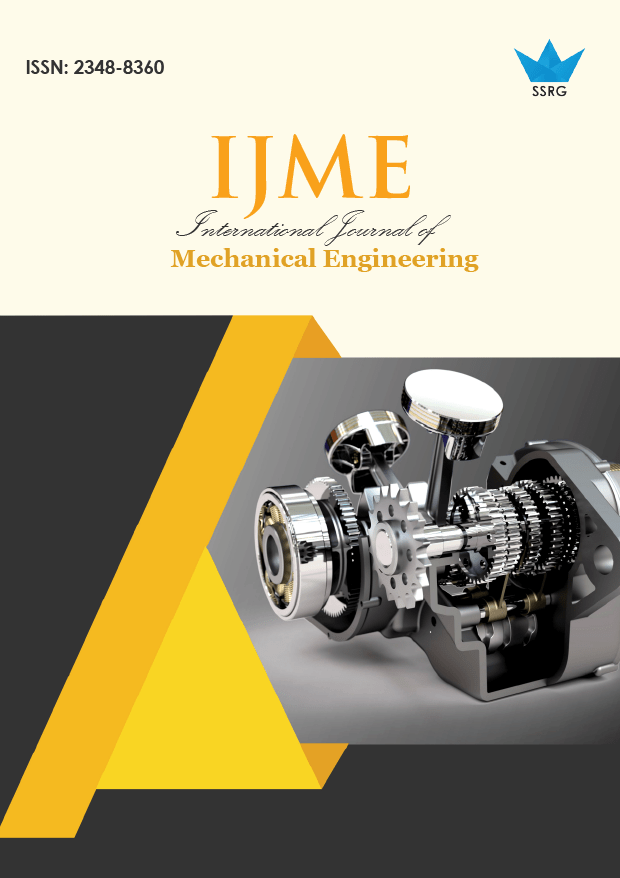Applying XFEM Analysis and Stochastic Approaches to Interfacial Crack Modeling in Bimaterial Systems with Void Inclusions

| International Journal of Mechanical Engineering |
| © 2025 by SSRG - IJME Journal |
| Volume 12 Issue 10 |
| Year of Publication : 2025 |
| Authors : M B Vaghela, Markad Kanif, Jay M. Pujara, C A Maradiya, J H Solanki, D B Patel |
How to Cite?
M B Vaghela, Markad Kanif, Jay M. Pujara, C A Maradiya, J H Solanki, D B Patel, "Applying XFEM Analysis and Stochastic Approaches to Interfacial Crack Modeling in Bimaterial Systems with Void Inclusions," SSRG International Journal of Mechanical Engineering, vol. 12, no. 10, pp. 46-59, 2025. Crossref, https://doi.org/10.14445/23488360/IJME-V12I10P105
Abstract:
Composite structures are extensively employed in various engineering applications to enhance strength and opt imize
overall performance through lightweight design. However, the complex manufacturing process of composite structures often
introduces discontinuities like voids, holes, inclusions, cracks, delamination, and flaws. The interfacial cracks, particular ly i nter
laminar debonding, interact with these discontinuities, posing a risk of failure in engineering components. Hence, studying S tress
Intensity Factor (SIF) for various materials with interface cracks is important to avoid calamitous failures in various engineering
applications. The stochastic approach is also applied by considering the random variables on material properties to obtain mo re
accurate and optimized results.
Keywords:
XFEM, COV, Mean, NISFs, Inclusion, Void, Interfacial crack.
References:
[1] M.L. Williams, “The Stresses Around a Fault or Crack in Dissimilar Media,” Bulletin of the Seismological Society of America, vol. 49, no. 2, pp. 199-204, 1959.
[CrossRef] [Google Scholar] [Publisher Link]
[2] G.C. Sih, P.C. Paris, and G.R. Irwin, “On Cracks in Rectilinearly Anisotropic Bodies,” International Journal of Fracture Mechanics, vol. 1, pp. 189-203, 1965.
[CrossRef] [Google Scholar] [Publisher Link]
[3] J. Dundurs, “Discussion: “Edge-Bonded Dissimilar Orthogonal Elastic Wedges Under Normal and Shear Loading,” Journal of Applied Mechanics, vol. 36, no. 3, pp. 650-652, 1969.
[CrossRef] [Google Scholar] [Publisher Link]
[4] J.R. Rice, “Elastic Fracture Mechanics Concepts for Interfacial Cracks,” Journal of Applied Mechanics, vol. 55, no. 1, pp. 98-103, 1988.
[CrossRef] [Google Scholar] [Publisher Link]
[5] C.W. Woo, and Y.H. Wano, “Analysis of an Edge Crack in a Finite Bi-Material Plate,” Engineering Fracture Mechanics, vol. 42, no. 2, pp. 289-297, 1992.
[CrossRef] [Google Scholar] [Publisher Link]
[6] Noriyuki Miyazaki et al., “Stress Intensity Factor Analysis of Interface Crack using Boundary Element Method: Application of Virtual Crack Extension Method,” JSME International Journal, Series A: Mechanics and Material Engineering, vol. 36, no. 1, pp. 36-42, 1993.
[CrossRef] [Google Scholar] [Publisher Link]
[7] W.T. Chow, H.G. Beom, and S.N. Atluri, “Calculation of Stress Intensity Factors for an Interfacial Crack between Dissimilar Anisotropic Media, using a Hybrid Element Method and the Mutual Integral,” Computational Mechanics, vol. 15, pp. 546-557, 1995.
[CrossRef] [Google Scholar] [Publisher Link]
[8] Xiaomin Deng, “Mechanics of Debonding and Delamination in Composites: Asymptotic Studies,” Composites Engineering, vol. 5, no. 10-11, pp. 1299-1315, 1995.
[CrossRef] [Google Scholar] [Publisher Link]
[9] Kwang-Ho Lee, Jai-Sug Hawong, and Sun-Ho Choi, “Dynamic Stress Intensity Factors KI, KII and Dynamic Crack Propagation Characteristics of Orthotropic Material,” Engineering Fracture Mechanics, vol. 53, no. 1, pp. 119-140, 1996.
[CrossRef] [Google Scholar] [Publisher Link]
[10] Christina Bjerkén, and Christer Persson, “A Numerical Method for Calculating Stress Intensity Factors for Interface Cracks in Biomaterials,” Engineering Fracture Mechanics, vol. 68, no. 2, pp. 235-246, 2001.
[CrossRef] [Google Scholar] [Publisher Link]
[11] Arun Shukla et al., “Photoelastic Investigation of Interfacial Fracture between Orthotropic and Isotropic Materials,” Optic and Lasers in Engineering, vol. 40, no. 4, pp. 307-324, 2003.
[CrossRef] [Google Scholar] [Publisher Link]
[12] N. Sukumar et al., “Partition of Unity Enrichment for Bimaterial Interface Cracks,” International Journal for Numerical Methods in Engineering, vol. 59, pp. 1075-1102, 2004.
[CrossRef] [Google Scholar] [Publisher Link]
[13] Stéphane Bordas et al., “An Extended Finite Element Library,” International Journal for Numerical Methods in Engineering, vol. 71, no. 6, pp. 703-732, 2007.
[CrossRef] [Google Scholar] [Publisher Link]
[14] Alexander Menk, and Stéphane P.A. Bordas, “Numerically Determined Enrichment Functions for the Extended Finite Element Method and Applications to Bi-Material Anisotropic Fracture and Polycrystals,” International Journal for Numerical Methods in Engineering, vol. 83, no. 7, pp. 805-828, 2010.
[CrossRef] [Google Scholar] [Publisher Link]
[15] S. Esna Ashari, and S. Mohammadi, “Delamination Analysis of Composites by New Orthotropic Bimaterial Extended Finite Element Method,” International Journal for Numerical Methods in Engineering, vol. 86, no. 13, pp. 1507-1543, 2011.
[CrossRef] [Google Scholar] [Publisher Link]
[16] Himanshu Pathak, Akhilendra Singh, and Indra Vir Singh “Numerical Simulation of Bi-Material Interfacial Cracks using EFGM and XFEM,” International Journal of Mechanics and Materials in Design, vol. 8, pp. 9-36, 2012.
[CrossRef] [Google Scholar] [Publisher Link]
[17] K. Sharma et al., “Analysis of a Subinterface Crack in Piezoelectric Bimaterials with the Extended Finite Element Method,” Engineering Fracture Mechanics, vol. 104, pp. 114-139, 2013.
[CrossRef] [Google Scholar] [Publisher Link]
[18] Hongfen Gao, and Gaofeng Wei, “Stress Intensity Factor for Interface Cracks in Bimaterials Using Complex Variable Meshless Manifold Methods,” Mathematical Problems in Engineering, vol. 2014, no. 1, pp. 1-8, 2014.
[CrossRef] [Google Scholar] [Publisher Link]
[19] X.F. Hu, J.N. Wang, and W.A. Yao, “A Size Independent Enriched Finite Element for the Modeling of Bimaterial Interface Cracks,” Computers & Structures, vol. 172, pp. 1-10, 2016.
[CrossRef] [Google Scholar] [Publisher Link]
[20] Sh. Akhondzadeh, A.R. Khoei, and P. Broumand, “An Efficient Enrichment Strategy for Modeling Stress Singularities in Isotropic Composite Materials with X-FEM Technique,” Engineering Fracture Mechanics, vol. 169, pp. 201-225, 2017.
[CrossRef] [Google Scholar] [Publisher Link]
[21] Yongxiang Wang et al., “XFEM with High-Order Material-Dependent Enrichment Functions for Stress Intensity Factors Calculation of Interface Cracks using Irwin’s Crack Closure Integral,” Engineering Fracture Mechanics, vol. 178, pp. 148-168, 2017.
[CrossRef] [Google Scholar] [Publisher Link]
[22] Fan CuiYing et al., “Fundamental Solutions and Analysis of the Interface Crack for Two-Dimensional Decagonal Quasicrystal Bimaterial via the Displacement Discontinuity Method,” Engineering Analysis with Boundary Elements, vol. 106, pp. 462-472, 2019.
[CrossRef] [Google Scholar] [Publisher Link]
[23] Ajay Kumar, Rajesh Ghosh, and Rajeev Kumar, “Effects of Interfacial Crack and Implant Material on Mixed-Mode Stress Intensity Factor and Prediction of Interface Failure of Cemented Acetabular Cup,” Journal of Biomedical Materials Research Part B: Applied Biomaterials, vol. 108, no. 5, pp. 1844-1856, 2019.
[CrossRef] [Google Scholar] [Publisher Link]
[24] Sha Xiao, Zhongqi Quentin Yue, and Hongtian Xiao, “Boundary Element Analysis of Transversely Isotropic Bi-Material Halfspaces with Inclined Planes of Isotropy and Interfaces,” International Journal for Numerical and Analytical Methods in Geomechanics, vol. 43, no. 17, pp. 2599-2627, 2019.
[CrossRef] [Google Scholar] [Publisher Link]
[25] Hao Chai, Jun Lv, and Yumei Bao, “Numerical Solutions of Hypersingular Integral Equations for Stress Intensity Factors of Planar Embedded Interface Cracks and their Correlations with Bimaterial Parameters,” International Journal of Solids and Structures, vol. 202, pp. 184-194, 2020.
[CrossRef] [Google Scholar] [Publisher Link]
[26] J.S. Kuang, and Y.H. Wang, “Bimaterial Interface Cracks Originating from Holes,” Mechanics Research Communications, vol. 22, no. 6, pp. 577-582, 1995.
[CrossRef] [Google Scholar] [Publisher Link]
[27] N. Sukumar et al., “Modeling Holes and Inclusions by Level Sets in the Extended Finite-Element Method,” Computer Methods in Applied Mechanics and Engineering, vol. 190, no. 46-47, pp. 6183-6200, 2001.
[CrossRef] [Google Scholar] [Publisher Link]
[28] Ted Belytschko, and Robert Gracie, “On XFEM Applications to Dislocations and Interfaces,” International Journal of Plasticity, vol. 23, no. 10-11, pp. 1721-1738, 2007.
[CrossRef] [Google Scholar] [Publisher Link]
[29] A.S. Shedbale, I.V. Singh, and B.K. Mishra, “Nonlinear Simulation of an Embedded Crack in the Presence of Holes and Inclusions by XFEM,” Procedia Engineering, vol. 64, pp. 642-651, 2013.
[CrossRef] [Google Scholar] [Publisher Link]
[30] S. Natarajan et al., “Numerical Analysis of the Inclusion-Crack Interaction by the Extended Finite Element Method,” International Journal for Computational Methods in Engineering Science and Mechanics, vol. 15, no. 1, pp. 26-32, 2014.
[CrossRef] [Google Scholar] [Publisher Link]
[31] K. Sharma, “Crack Interaction Studies Using XFEM Technique,” Journal of Solid Mechanics, vol. 6, no. 4, pp. 410-421, 2014.
[Google Scholar] [Publisher Link]
[32] A. Tafreshi, “Computation of the Jk-Integrals for Bimaterial Interface Cracks using Boundary Element Crack Shape Sensitivities,” Theoretical and Applied Fracture Mechaics, vol. 82, pp. 77-87, 2016.
[CrossRef] [Google Scholar] [Publisher Link]
[33] M.T. Ebrahimi et al., “Discrete Crack Dynamics: A Planar Model of Crack Propagation and Crack-Inclusion Interactions in Brittle Materials,” International Journal of Solids and Structures, vol. 152-153, pp. 12-27, 2018.
[CrossRef] [Google Scholar] [Publisher Link]
[34] Tiantang Yu, and Tinh Quoc Bui, “Numerical Simulation of 2-D Weak and Strong Discontinuities by a Novel Approach based on XFEM with Local Mesh Refinement,” Composite Structures, vol. 196, pp. 112-133, 2018.
[CrossRef] [Google Scholar] [Publisher Link]
[35] Al Emran Ismail et al., “Calculating of Stress Intensity Factors of Soldered Joints with Multiple Cracks,” Indonesian Journal of Electrical Engineering and Computer Science, vol. 14, no. 1, pp. 284-289, 2019.
[CrossRef] [Google Scholar] [Publisher Link]
[36] Eric B. Chin, and N. Sukumar, “Modeling Curved Interfaces without Element-Partitioning in the Extended Finite Element Method,” International Journal for Numerical Methods in Engineering, vol. 120, no. 5, pp. 607-649, 2019.
[CrossRef] [Google Scholar] [Publisher Link]
[37] Junlei Ding, Tiantang Yu, and Tinh Quoc Bui, “Modeling Strong_Weak Discontinuities by Local Mesh Refinement Variable-Node XFEM with Object-Oriented Implementation,” Theoretical and Applied Fracture Mechanics, vol. 106, pp. 1-42, 2020.
[CrossRef] [Google Scholar] [Publisher Link]
[38] Achchhe Lal, and Shailesh P. Palekar, “Stochastic Fracture Analysis of Laminated Composite Plate with Arbitrary Cracks using X-FEM,” International Journal of Mechanics and Materials in Design, vol. 13, pp. 195-228, 2017.
[CrossRef] [Google Scholar] [Publisher Link]
[39] Achchhe Lal et al., “Stochastic Extended Finite Element Implementation for Fracture Analysis of Laminated Composite Plate with a Central Crack,” Aerospace Science and Technology, vol. 60, pp. 131-151, 2017.
[CrossRef] [Google Scholar] [Publisher Link]
[40] Khubilal Khatri, and Achchhe Lal, “Stochastic XFEM Fracture and Crack Propagation Behavior of an Isotropic Plate with Hole Emanating Radial Cracks Subjected to Various in-Plane Loadings,” Mechanics of Advanced Materials and Structures, vol. 25, no. 9, pp. 732-755, 2018.
[CrossRef] [Google Scholar] [Publisher Link]
[41] Khubilal Khatri, and Achchhe Lal, “Stochastic XFEM based Fracture Behavior and Crack Growth Analysis of a Plate with a Hole Emanating Cracks under Biaxial Loading,” Theoretical and Applied Fracture Mechanics, vol. 96, pp. 1-22, 2018.
[CrossRef] [Google Scholar] [Publisher Link]
[42] K.H. Lee, “Stress and Displacement Fields for Propagating the Crack Along the Interface of Dissimilar Orthotropic Materials Under Dynamic Mode I and II Load,” Journal of Applied Mechanics, vol. 67, no. 1, pp. 223-228, 2000.
[CrossRef] [Google Scholar] [Publisher Link]
[43] Soheil Mohammadi, Extended Finite Element Method: For Fracture Analysis of Structures, Willey, pp. 1-280, 2008.
[Google Scholar] [Publisher Link]
[44] Alireza Asadpoure, Soheil Mohammadi, and Abolhasan Vafai, “Crack Analysis in Orthotropic Media using the Extended Finite Element Method,” Thin Walled Structures, vol. 44, no. 9, pp. 1031-1038, 2006.
[CrossRef] [Google Scholar] [Publisher Link]
[45] Wen Wang et al., “Numerical Simulation of Interfacial and Subinterfacial Crack Propagation by using Extended Peridynamics,” Computers and Structures, vol. 279, 2023.
[CrossRef] [Google Scholar] [Publisher Link]
[46] R. Nikhil et al., “Application of an Instability-Based Fracture Model for Prediction of Crack Initiation in Modified 9Cr–1Mo Steel,” Fatigue & Fracture of Engineering Materials & Structures, vol. 48, no. 2, pp. 857-870, 2025.
[CrossRef] [Google Scholar] [Publisher Link]
[47] Ping Li et al., “A Novel Strength-Energy Criterion for Bimaterial Interface Crack Propagation,” International Journal of Solids and Structures, vol. 298, 2024.
[CrossRef] [Google Scholar] [Publisher Link]
[48] María A. Herrera-Garrido, and Vladislav Mantič, “Stress Singularities in the Generalised Comninou Frictional Contact Model for Interface Cracks in Anisotropic Bimater,” Journal of the Mechanics and Physics of Solids, vol. 203, 2025.
[CrossRef] [Google Scholar] [Publisher Link]
[49] Shailesh P. Palekar et al., “Probabilistic Fracture Analysis of Double Edge Cracked Orthotropic Laminated Plates using the Stochastic Extended Finite Element Method,” Forces in Mechanics, vol. 14, pp. 1-17, 2024.
[CrossRef] [Google Scholar] [Publisher Link]

 10.14445/23488360/IJME-V12I10P105
10.14445/23488360/IJME-V12I10P105